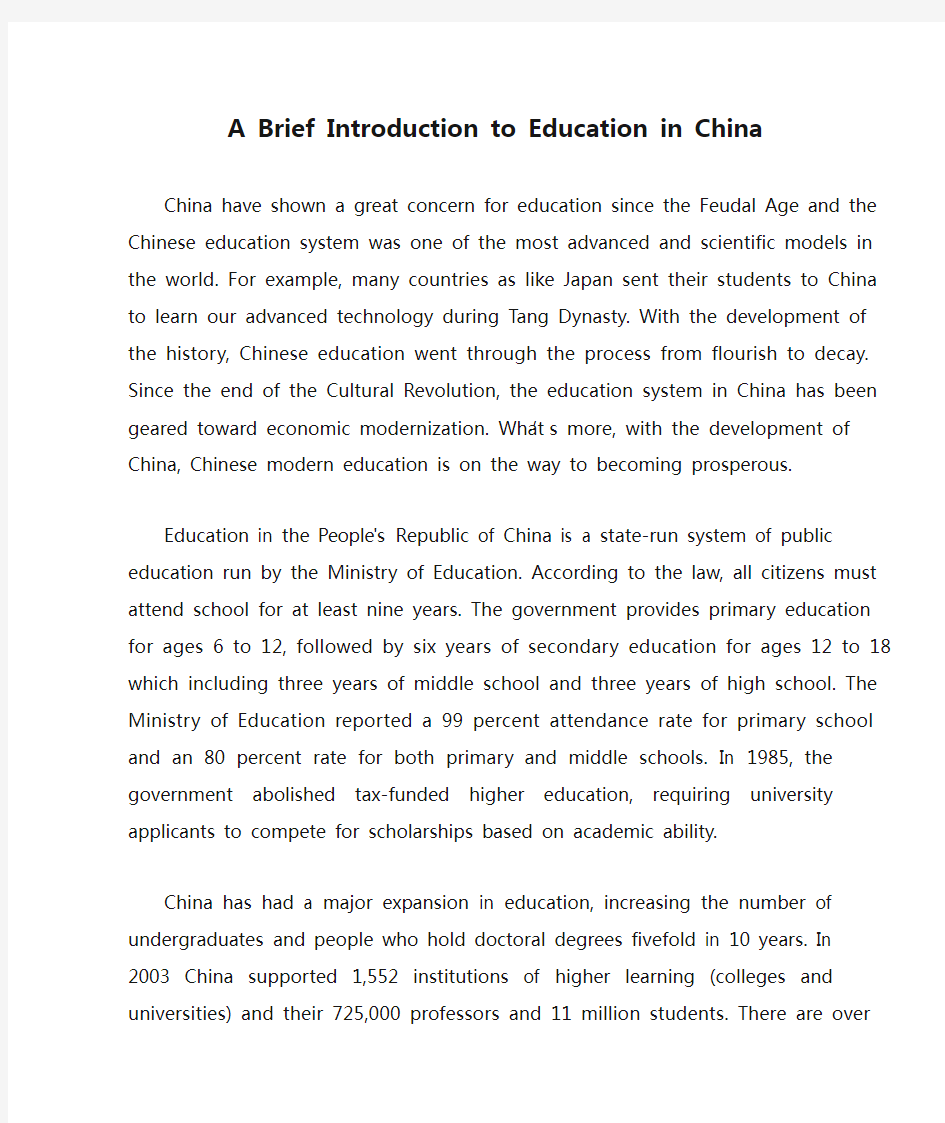A Brief Introduction to Education in China


A Brief Introduction to Education in China
China have shown a great concern for education since the Feudal Age and the Chinese education system was one of the most advanced and scientific models in the world. For example, many countries as like Japan sent their students to China to learn our advanced technology during Tang Dynasty. With the development of the history, Chinese education went through the process from flourish to decay. Since the end of the Cultural Revolution, the education system in China has been geared toward economic modernization. What’s more, with the development of China, Chinese modern education is on the way to becoming prosperous.
Education in the People's Republic of China is a state-run system of public education run by the Ministry of Education. According to the law, all citizens must attend school for at least nine years. The government provides primary education for ages 6 to 12, followed by six years of secondary education for ages 12 to 18 which including three years of middle school and three years of high school. The Ministry of Education reported a 99 percent attendance rate for primary school and an 80 percent rate for both primary and middle schools. In 1985, the government abolished tax-funded higher education, requiring university applicants to compete for scholarships based on academic ability.
China has had a major expansion in education, increasing the number of undergraduates and people who hold doctoral degrees fivefold in 10 years. In 2003 China supported 1,552 institutions of higher learning (colleges and universities) and their 725,000 professors and 11 million students. There are over 100 National Key Universities, including Beijing University and Tsinghua University.
Elementary Education
Elementary education divided into preschool education and primary education.
Preschool education begins at age three and its aim is to prepare for the primary schools. Preschool facilities are to be established in buildings made available by public enterprises, municipal authorities, local government and groups. The government announces that it depend on individual organizations to sponsor their own preschool education and that preschool education is to become a part of the welfare services of various government organizations, institutes, and state- and collectively operated enterprises. Costs for preschool education varied according to services rendered because it doesn’t belong to the nine-year compulsory education.
Primary schools are to be tuition-free and reasonably located for the convenience of children attending them; students will attend primary schools in their neighborhoods or villages. Parents pay a small fee per term for books and other expenses such as transportation, food, and heating. In addition, under the education reform, students from poor families received stipends, and state enterprises, institutions, and other sectors of society are encouraged to establish their own schools.
The primary-school curriculum consists of Chinese, mathematics, physical education, music, drawing, nature, history, geography and general knowledge of politics and moral training, which stresses love of the motherland, love of the party, and love of the people. A foreign language, often English, is introduced in about the first grade. Chinese and mathematics accounted for about 60 percent of the scheduled class time; natural science and social science accounted for about 8 percent. Putonghua (common spoken language) was taught in regular schools and pinyin romanization in lower grades and kindergarten
Secondary Education
Secondary education consists of junior high school, senior high school and vocation technical school,
Under the Law on Nine-Year Compulsory Education, junior high schools are also to be tuition-free and it consists the last three years of nine years compulsory education.
After graduating from junior high school, there will be two choices: senior high school or vocation technical school.
Senior secondary education often refers to three years high school (or called senior middle school) education, as from grade 10 to grade 12. Normally, students who have finished six years of primary education will continue another three years of academic study in senior high schools. However, it is not compulsory for senior secondary education, but it is the only way to go to university. In addition, they also can gain vocational education in vocational high schools.
Generally, high school years usually have two semesters, starting in September and February. The academic curriculum consists of Chinese, Mathematics, English, Physics, Chemistry, Biology, Geography, History,Political , Music, Fine Arts, PE, Technology, Computing etc. Some schools may also offer vocational subjects. Generally speaking, the proportion of the total of Mathematics,Chinese and English is high in College Entrance Examination. In most provinces, senior high schools divides into liberal arts and science,so it will have different test in College Entrance Examination
V ocational education embraces higher vocational schools, secondary skill schools, vestibule schools, vocational high schools, job-finding centers and other adult skill and social training institutes. To enable vocational education to better accommodate the demands of economic re-structuring and urbanization, in recent years the government has remodeled vocational education, oriented towards obtaining employment, and focusing on two major vocational education projects to meet society's ever more acute demand for high quality, skilled workers. These are cultivating skilled workers urgently needed in modern manufacture and service industries; and training rural laborers moving to urban areas.
Higher Education
Higher education at the undergraduate level includes two-or three-year junior colleges(sometimes also called short-cycle colleges, four-year colleges) and universities offering programs in both academic and vocational subjects. Many colleges and universities also offer graduate programs leading to t he master’s or Ph.D. degree.
Chinese higher education at the undergraduate level is divided into three-year and four-year programs. The former is offered not only at short-cycle colleges, but frequently also at four-year colleges and universities. The latter is offered at four-year colleges and universities but do not always lead to the bachelor’s degree.
